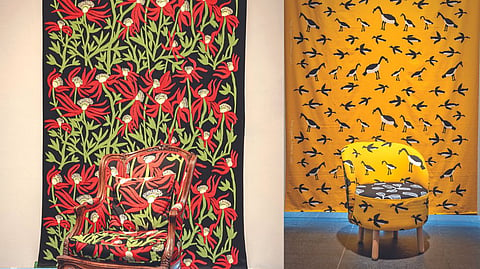

CHENNAI: The Australian Consulate-General is hosting an exhibition of aboriginal art in the city. Titled Jarracharra, the exhibition highlights the importance Australia places on its First Nations cultures as a vital part of its national identity. Sarah Kirlew, the Australian Consul General for South India, hopes that the exhibition will prompt people to be curious to learn more about Australia’s First Nations people and maybe, consider taking a trip to Australia to learn more about this aspect. “We are exhibiting 24 screen-printed textiles from 15 female First Nations artists from the Bábbarra Women's Centre. The exhibition is titled ‘Jarracharra’ for the name given to a distinctive cool wind that blows across Arnhem Land in Australia’s far north in the dry season. The arrival of the Jarracharra wind signifies a time of the year when people come together for special ceremonies. The name is used by the artists for this exhibition because Bábbarra has brought diverse women together for over 35 years,” Sarah tells DT Next.
First Nations include Aboriginal people from mainland Australia and Torres Strait Islander people from coastal areas between the northern tip of Australia and Papua New Guinea. “Aboriginal art reflects the depth of that longstanding culture. It is also a continually evolving art form with artists experimenting with new mediums. The earliest forms of Aboriginal art were rock carvings and paintings, body paintings and ground designs. The artworks also share knowledge about traditional bush foods and harvests such as yams, barramundi (a type of fish) and long-necked turtles. Dilly bags and woven fish traps and other objects traditionally made by women to collect food and carry children are also depicted. The stories also include creation spirits such as yawkyawk (mermaid spirits). First Nations Australians also use their art as a form of political expression. Artist Richard Bell was shown at the Kochi Biennale this year and explores themes of colonialism, dispossession, and inequality,” she quips.
Sarah says the team were interested to explore the synergies between Australian and Indian textile artists. The Jarracharra exhibition being shown in Chennai debuts new pieces developed collaboratively when artists from the Bábbarra Women’s Centre visited the Tharangini studio in Bengaluru in early 2023. “The new co-created textiles use traditional Indian woodblock carving techniques to produce Australian aboriginal designs. One of the items on display is a sari piece made this way. Australian First Nations artists draw on centuries of cultural tradition when selecting designs, motifs and imagery to include in their work. The designs are carefully handed down through the generations binding together families and clans; the same way that Indian textile weavers and handloom experts also pass their skills and craft down the generations. I think visitors to the exhibition will also be struck by the exuberant use of colour which also resonates with a broader Indian sensibility,” Sarah concludes. The exhibition is on till April 17 at Kingsley, Spurtank Road, Chetpet.
Visit news.dtnext.in to explore our interactive epaper!
Download the DT Next app for more exciting features!
Click here for iOS
Click here for Android